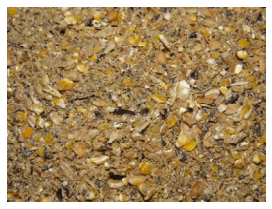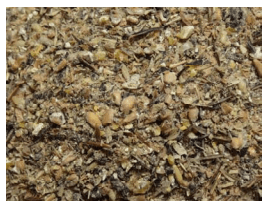In modern poultry nutrition, traditional fibre sources are associated with some negative attributes such as energy dilution of the diet and mycotoxin contamination and are usually not included during linear formulation. However, fibre is also suggested to have a positive effect on the intestinal microflora and the intestinal health including for poultry. While some nutritionists believe that crude fibre is an integral part of the poultry diet, others argue that its inclusion in poultry diets is not necessary.
Dietary fibre has been described as the skeletal remains of plant cells in diets that are not digested by monogastric animal. Fibre is a nutritionally, chemically and physically heterogeneous material. This heterogeneous mix can be categorized into two major subclasses i.e., water soluble (viscous and fermentable fibre) and insoluble (no viscous and no fermentable sources). Differentiation of soluble and insoluble fibre components has helped elucidate the physiological effects of crude fibre as the two subclasses have different roles in the digestive/absorptive processes within the gastrointestinal tract (table 1).
Table 1: Soluble versus insoluble fibre.
The amount but also the structure of fibre is very variable between different plant materials. In addition to straw or hulls from cereals or even lignin from wood, major raw materials with high insoluble fibre contents are cereals by-products such as rice or wheat bran, sunflower meal, palm kernel meal, beat pulp, etc.
Role of insoluble fibre highly documented in layers.
The insoluble fraction used to be considered as performing an exclusively nutrient dilution role. However, many studies report that insoluble fibre (non starch polysaccharides – NSP - and lignin) affects gut function and modulates nutrient digestion. These effects result from insoluble fraction fibre accumulating in the gizzard. The resultant well developed gizzard improves grinding capacity which reduces the amount of coarse particles entering the small intestine contributing to an increased nutrient availability and nutrient utilization.
Published studies provide evidence that insoluble NSP’s increase the growth of beneficial bacteria that stimulate both intestinal and overall health status. High-starch diets favour fermentation in the small intestine where pathogens can quickly multiply creating a situation with high risk of microbial imbalance and intestinal disease in the host. Increased insoluble dietary fibre in the diet increases gizzard volume and results in a longer retention time which allows for more hydrochloric acid secretion. This combined with a stimulatory effect of gizzard activity on acid secretion, will lower pH of the gizzard content. Both a lower pH and the poorly fermentable fibre fraction favour a higher proportion of beneficial micro-organisms in the bird’s gut and in the environment. This effect promotes the integrity of the intestinal lining, improved nutrient digestion in the lower intestine and litter quality.
Furthermore, in addition to other factors such as feed presentation, mineral and amino-acid balance, it has been shown in many studies especially with layers that feeding high-fibre and low-energy diets, or roughages reduces or prevents feather peaking. Providing high insoluble NSP diets or straw in the litter during rearing could result in lower levels of stereotypic behaviours such as tail pecking in adults.
It appears that hens fed with low energy diets compensate for the lower energy concentration by increasing feed intake. However, addition of fibrous structural components may also be deleterious for performance at too high levels because of a reduced nutrient intake. When the reduction in dietary energy concentration does not exceed 10 %, the layer performance and body weights do not appear to be affected by the dietary changes.
The wild ancestors to our domesticated poultry species spent around 60 per cent of their time searching for food and had a diet consisting of a large amount of structural components such as seeds and durable fibrous materials. It is thought that behaviour such as feather pecking that causes so much concern in current layer production is a substitute for normal ground pecking or feeding behaviour in the absence of adequate foraging incentives because of modern feeds are nutrient-dense and readily available.
Low density poultry diets: Field experience in broiler breeder diets.
Feed restriction of broiler breeders and possible hunger implications may lead to excessive water intake, stereotypic pecking directed towards objects in the environment and a general increase in activity. Attempts to feed broiler breeders with diluted and high fibre diet in order to increase satiety is receiving more attention today due to observed improvements in bird welfare.
Research works and some field experiments suggest that when low ME diets were fed in the rearing period, these may help to promote flock uniformity, to delay the reproductive tract development and to increase early egg size. Other studies with low density broiler breeder diets during lay showed an increase in egg and day old chick weight, an improved growth rate and a reduced mortality in the progeny.
Hubbard’s internal field trials together with some preliminary experiences at customer level confirm the positive effect of diluted breeder diets especially in the rearing stage (2,350 to 2,600 Kcal/kg grower diet, see picture 1 and 2):
- The feed clean up time is increased by 5 - 15 minutes in rearing and 30 - 90 minutes in production according to the dilution applied. Less effort is needed to achieve the correct flock uniformity.
- The birds are calmer. It prevents feather pulling.
- It is easier to control litter quality (dryer litter)
- Liveability in rearing and production is improved in most cases.
Picture 1: Standard 2,620 Kcal/kg grower diet
Picture 2: Diluted 2,400 Kcal/kg grower diet
However some critical points need to be emphasized when making such dietary changes in broiler breeders:
- For all high fibre diets it is essential that growth of the broiler breeders remains in the range recommended for the given breed and with low ME diets, the birds should eat quantitatively more feed than observed normally with higher ME diets. Staff in charge of breeder flocks should always adjust feed allocation according to the evolution of bodyweight.
- It is also very important that water is sufficiently available to allow swelling of the food to aid the feeling of satiety from gut fill
- Special attention needs to be paid to the transitional phases when the feed is changed from a high density starter ration to the diluted grower ration and when returning back to the normal density breeder ration. This is particularly true when grower diets are less than 2,500 Kcal/kg.
- When using mash feed, it may be difficult to get a uniform and coarse mash while using fibrous but fine raw materials such as wheat bran.
In case welfare regulations do not allow non-feeding days or when one is facing difficulties to achieve correct uniformity in general and with breeders especially males becoming more voracious, low density diets are preferred to maximise feed volume, increase feeding time and gut fill.
Summary and perspectives.
Recent work in broilers concluded that the inclusion of insoluble fibre in broiler diets may also improve growth performance. Chickens appear to have a desire for structural components and will search for structural components which need to be coarse and insoluble. In a situation where the diet has a low fibre content, litter material used as bedding in floor systems may be an alternative source for structural components. However, these observations support the author’s opinion that the poultry industry focuses too much on concentration of nutrients while the supply of adequate insoluble fibre has not been properly managed until now. Of course the correct intake of energy, amino-acids and trace elements is important, but more attention should be paid to dietary insoluble fibre not only in layer nutrition but also for breeders and broilers fed without antibiotic growth promoters.
The trend to lower density diets will also be affected by the availability and cost of raw materials and its quality. For some high fibre ingredients, the ME content for poultry may not be well defined while some ingredients may increase the risk of contamination such as mycotoxins concentrated in fibrous seed coatings.
It is important to note that the negative results reported on some type of fibrous sources (soluble fibre) can be eliminated with enzyme supplementation and with a feed processing adequately planned to suit the requirement of the specific type and age of bird to be fed. With that strategy, when available, feedstuffs that are high in fibre can be used to dilute poultry feed conveniently.
Since no systematic studies have been undertaken to quantify the optimal amount of structural components in poultry diets, this discussion about an optimal poultry diet structure cannot be concluded with firm recommendations. Considering current knowledge, a general and practical recommendation could be to ensure that, after 3 weeks of age, the diet either contains a sufficient amount of coarse cereal particles, or that the content of coarse and durable fibres such as oat hulls (or equivalent) is included at 5 – 8 % for breeder diets and 2 - 3% in broiler diets.

















.jpg&w=3840&q=75)